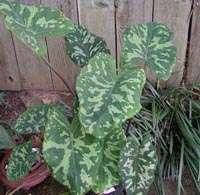Resource Library
Plant of the Week: Hilo Beauty Elephant Ear
The University of Arkansas System Division of Agriculture does not promote, support or recommend plants featured in "Plant of the Week." Please consult your local Extension office for plants suitable for your region.
Plant of the Week
Hilo Beauty Elephant Ear
Latin: Alocasia 'Hilo Beauty'

Names - either of an individual or an object - provide a basic means of ordering our world. Plant names are a frustration to many gardeners because, unless you limit your choices to the ordinary and mundane, they are challenging to remember, hard to pronounce and oftentimes confused.
Hilo Beauty elephant ear is anything but mundane, but it does show that even the experts sometimes have trouble agreeing on a name.
What are the characteristics of the alocasia elephant ear?
Alocasia ‘Hilo Beauty’ is tropical member of the philodendron family with the heart-shaped leaves of an elephant ear, but each leaf is marked with various shades of green in a camouflaged pattern that any G I outfitted for jungle warfare would be proud of. Plants grow about 2 feet tall and wide with individual leaves to a foot long and rising from the soil.
Apparently, the plant makes a short rhizome somewhat like a caladium, not the upright trunk found on Alocasia macrorrhizos (Elephant Ear) or the large fleshy tuber of Colocasia esculenta (also called Elephant Ear). Hilo Beauty is a hybrid, but no one is sure what species were involved in the cross, since the plant doesn’t flower. To accurately identify the plant to genus, flowers are critical.
So, depending on the point of view of aroid experts, Hilo Beauty has been classified as belonging to one of four separate genera. The commercial propagators who have it in tissue culture and are mass producing it for the retail trade have chosen to call it Alocasia, so Alocasia it becomes.
I first encountered Hilo Beauty last January at a nursery trade show where one of our Arkansas greenhouse growers, Tim Owens of Pleasant Valley Greenhouses in Van Buren, had it in his booth. Tim said every person who stopped wanted to talk about the Hilo Beauty because it was so striking and had "fast sales" written all over it.
It turns out Pleasant Valley was test growing the plant for a major promotion planned for June for one of the big box merchants. Aroids are easy to propagate in tissue culture, so one Florida lab now mass produces this beauty.
Tracking down the origins of Hilo Beauty is not an easy task. The aroid chat room has been talking about it since 1997, and one even referred to it as an "old" plant, but none of my references list it, so if it is indeed old, it was never common. Some people suggest it’s possibly a natural hybrid found in Hawaii between an Alocasia and Caladium, but all of this is just speculation.
How do I care for my Hilo Beauty?
Hilo Beauty is probably best suited for use in a container garden on the patio where the beautiful dappled foliage can be mixed with other interesting foliage plants. It can also be grown in outdoor beds, but don’t expect it to overwinter in our area. It’s hardy in zone 9, but not this far north. Keep it uniformly moist and feed it occasionally to keep it growing. A bright location, but with protection from the hot afternoon sun is probably best. The rhizome can be overwintered in a pot of soil inside, but don’t allow it to get below 45 degrees.
By: Gerald Klingaman, retired
Extension Horticulturist - Ornamentals
Extension News - June 3, 2005
The University of Arkansas System Division of Agriculture does not maintain lists of retail outlets where these plants can be purchased. Please check your local nursery or other retail outlets to ask about the availability of these plants for your growing area.